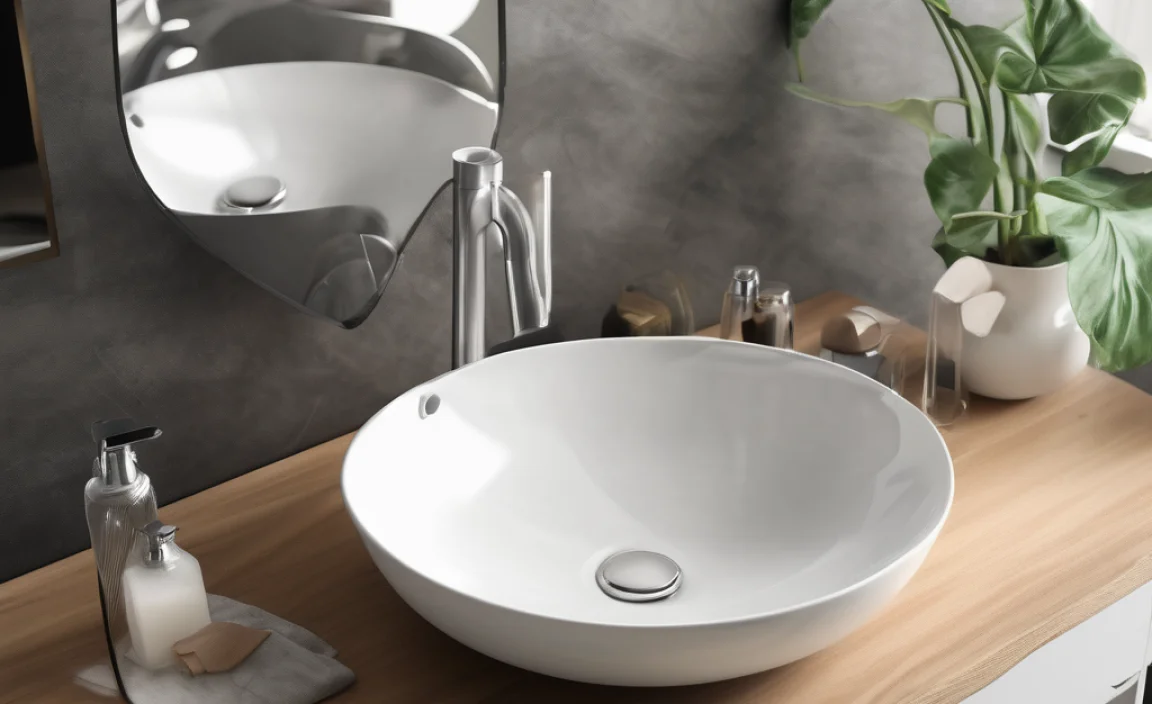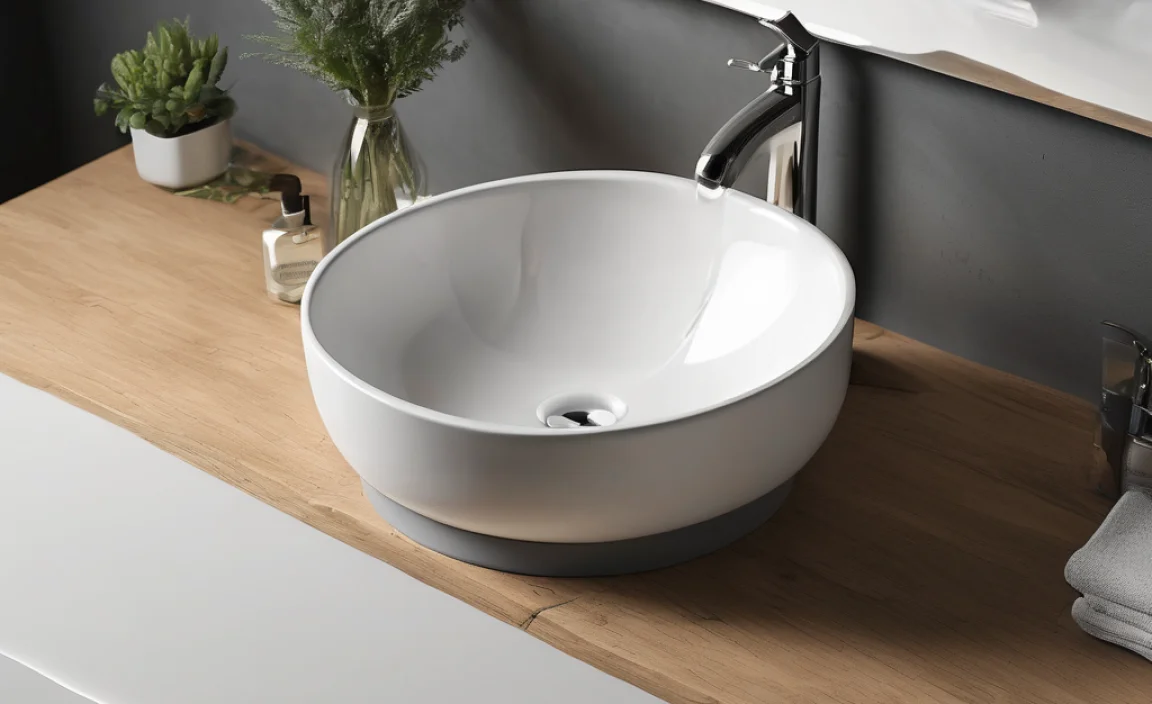Mounting a vessel sink seems tricky, but it’s totally doable! You’ll need to attach the sink securely to your countertop and connect the plumbing properly. This guide will walk you through each step, so you can get it done right the first time. We’ll cover everything from tools and materials to the final plumbing connections. Let’s get started and turn your bathroom into a stylish space!
Introduction: Adding Style with a Vessel Sink

Vessel sinks are a super popular way to add a touch of modern style to your bathroom. They sit right on top of the counter, making them a focal point. But, installing one can feel a bit scary if you’ve never done it before. Don’t worry! This guide breaks down the process into simple, easy-to-follow steps.
We’ll show you exactly what tools you need, how to prepare your countertop, and how to connect the plumbing without leaks. By the end of this article, you’ll have the confidence to mount your vessel sink like a pro. Get ready to upgrade your bathroom with this straightforward DIY project!
Tools and Materials You’ll Need

Before you begin, gather all the necessary tools and materials. Having everything on hand will make the installation process smooth and efficient. Here’s a list of what you’ll need:
- Vessel sink
- Mounting ring or silicone sealant
- Pencil
- Measuring tape
- Drill with appropriate drill bits (for faucet installation)
- Wrench
- Adjustable pliers
- Plumber’s tape
- Level
- Safety glasses
- Gloves
- Clean rags
- Pop-up drain assembly
- Supply lines
- P-trap
Step-by-Step Guide to Mounting Your Vessel Sink

Follow these steps carefully to ensure a successful vessel sink installation. Each step is designed to be clear and easy to understand, even if you’re a beginner.
Step 1: Prepare the Countertop
First, make sure your countertop is clean and ready for the new sink. Wipe it down with a damp cloth and ensure it’s completely dry. This helps with adhesion if you’re using silicone.
- Clean the Surface: Remove any dirt, dust, or debris from the countertop.
- Check for Level: Use a level to ensure the countertop is even. If it’s not, you might need to shim the base of the cabinet.
Step 2: Position the Sink and Mark the Drain Hole
Carefully place the vessel sink on the countertop where you want it. Use a pencil to trace the outline of the sink base. This will help you center it correctly.
- Center the Sink: Ensure the sink is centered and aligned with the faucet.
- Mark the Drain Hole: Use the sink’s drain opening as a guide to mark the spot for the drain hole on the countertop.
Step 3: Drill the Faucet Hole (If Necessary)
If your faucet isn’t mounted to the wall, you’ll need to drill a hole in the countertop for the faucet. Use a drill bit that matches the diameter of the faucet base.
- Choose the Right Drill Bit: Use a hole saw or a drill bit designed for the countertop material (e.g., diamond bit for stone).
- Drill Slowly: Apply steady pressure and drill slowly to avoid chipping or cracking the countertop.
Consult the faucet manufacturer’s instructions for the exact hole size and placement.
Step 4: Install the Mounting Ring or Apply Silicone Sealant
Some vessel sinks come with a mounting ring to provide extra stability. If yours does, place it on the countertop within the traced outline. If not, use silicone sealant.
- Mounting Ring: Center the mounting ring and secure it with adhesive if necessary.
- Silicone Sealant: Apply a bead of silicone sealant around the traced outline on the countertop.
Step 5: Place the Vessel Sink
Carefully lower the vessel sink onto the mounting ring or the silicone sealant. Press down gently to ensure it adheres properly.
- Align the Sink: Make sure the sink is aligned with the traced outline.
- Apply Pressure: Press down firmly but gently to secure the sink.
Step 6: Install the Drain Assembly
Insert the drain assembly into the drain hole from inside the sink. Follow the manufacturer’s instructions to tighten the drain assembly from underneath the countertop.
- Insert the Drain: Place the drain flange into the sink’s drain opening.
- Tighten the Nut: From underneath, attach the rubber and cardboard washers, then tighten the nut to secure the drain.
Step 7: Connect the Water Supply Lines
Attach the water supply lines to the faucet. Use plumber’s tape on the threads to prevent leaks.
- Wrap with Plumber’s Tape: Wrap the threads of the faucet inlets with plumber’s tape.
- Attach Supply Lines: Connect the water supply lines to the faucet and tighten with a wrench.
Step 8: Connect the P-Trap
Connect the P-trap to the drain assembly and the drainpipe in the wall. Make sure all connections are tight to prevent leaks.
- Assemble the P-Trap: Connect the P-trap components.
- Tighten Connections: Tighten all connections by hand, then use adjustable pliers for a snug fit.
Step 9: Test for Leaks
Turn on the water supply slowly and check for leaks around the drain assembly, faucet connections, and P-trap. Tighten any connections that are leaking.
- Turn on Water Slowly: Gradually turn on the water to check for leaks.
- Check Connections: Inspect all connections for any signs of leaks.
Step 10: Clean Up
Once you’ve confirmed there are no leaks, clean up any excess silicone sealant and remove any tools or materials from the area.
- Remove Excess Sealant: Use a damp cloth to wipe away any excess silicone.
- Final Check: Give the entire installation one last look to ensure everything is secure and clean.
Choosing the Right Vessel Sink

Selecting the right vessel sink is crucial for both aesthetics and functionality. Here’s what to consider:
- Material: Common materials include ceramic, glass, stone, and metal. Each offers a different look and durability.
- Shape and Size: Choose a shape and size that complements your countertop and bathroom space.
- Style: Consider the overall style of your bathroom. Modern, traditional, or eclectic – pick a sink that fits.
- Faucet Compatibility: Ensure the sink is compatible with your chosen faucet style (wall-mounted, vessel faucet, etc.).
Faucet Options for Vessel Sinks

The right faucet can make or break the look of your vessel sink. Here are some popular choices:
- Vessel Faucets: Designed specifically for vessel sinks, these are taller to reach over the sink’s height.
- Wall-Mounted Faucets: These save counter space and offer a sleek, modern look.
- Counter-Mounted Faucets: These are installed directly on the countertop next to the sink.
Common Mistakes to Avoid
Avoid these common mistakes to ensure a successful installation:
- Forgetting Plumber’s Tape: Always use plumber’s tape on threaded connections to prevent leaks.
- Overtightening Connections: Overtightening can damage the fittings. Tighten until snug, but not excessively.
- Ignoring Manufacturer’s Instructions: Always read and follow the manufacturer’s instructions for both the sink and the faucet.
- Skipping the Leak Test: Always test for leaks before finishing the installation.
Maintenance Tips for Vessel Sinks
Keep your vessel sink looking its best with these maintenance tips:
- Clean Regularly: Wipe down the sink regularly with a mild soap and water.
- Avoid Abrasive Cleaners: Abrasive cleaners can scratch the surface of the sink.
- Check for Leaks: Periodically check for leaks around the drain and faucet connections.
- Use a Drain Strainer: A drain strainer can prevent clogs by catching hair and debris.
Troubleshooting Common Issues
Here’s how to handle some common issues you might encounter:
| Issue | Solution |
|---|---|
| Leaking Drain | Tighten the drain assembly nut or replace the rubber washers. |
| Leaking Faucet Connections | Tighten the connections or add more plumber’s tape. |
| Slow Drain | Check for clogs in the P-trap or drainpipe. |
| Wobbly Sink | Ensure the mounting ring is secure or add shims under the sink base. |
Cost Considerations for Vessel Sink Installation
Understanding the costs involved can help you budget effectively for your project. Here’s a breakdown:
| Item | Estimated Cost |
|---|---|
| Vessel Sink | $50 – $500+ (depending on material and brand) |
| Faucet | $50 – $300+ |
| Drain Assembly | $20 – $50 |
| Supply Lines and P-Trap | $20 – $50 |
| Silicone Sealant and Plumber’s Tape | $10 – $20 |
| Professional Installation (if needed) | $150 – $400+ |
Advantages and Disadvantages of Vessel Sinks
Consider the pros and cons before deciding on a vessel sink:
Advantages:
- Stylish Design: Adds a modern and unique look to your bathroom.
- Easy Installation: Relatively easy to install compared to other types of sinks.
- Space Saving: Can save space in smaller bathrooms.
- Variety of Options: Available in a wide range of materials, shapes, and sizes.
Disadvantages:
- Counter Space: Takes up more counter space than under-mount sinks.
- Splashing: Can sometimes cause more splashing due to the height.
- Cleaning: Can be harder to clean around the base.
- Accessibility: May not be ideal for individuals with mobility issues due to the height.
FAQ: Mounting a Vessel Sink
Here are some frequently asked questions about mounting vessel sinks:
1. Do I need special tools to mount a vessel sink?
Not really. You’ll need basic plumbing tools like a wrench, adjustable pliers, and plumber’s tape. A drill might be needed if you’re installing a new faucet.
2. Can I install a vessel sink on any countertop?
Most countertops work well with vessel sinks. Just ensure the countertop is level and sturdy enough to support the sink’s weight.
3. How do I prevent leaks when installing a vessel sink?
Use plumber’s tape on all threaded connections and ensure all nuts and bolts are tightened properly. Silicone sealant around the base can also help.
4. What kind of faucet should I use with a vessel sink?
Vessel faucets are designed specifically for vessel sinks because they are taller. Wall-mounted faucets are another stylish option.
5. How do I clean a vessel sink?
Use a mild soap and water solution. Avoid abrasive cleaners that can scratch the surface. Regular cleaning will keep your sink looking its best.
6. Is it difficult to replace a vessel sink?
Replacing a vessel sink is generally straightforward. Just disconnect the plumbing, remove the old sink, and install the new one following the same steps.
7. What if my countertop isn’t perfectly level?
Use shims under the base of the sink to level it. This will prevent wobbling and ensure proper drainage.
Conclusion: Enjoy Your New Vessel Sink
You’ve done it! By following these steps, you’ve successfully mounted your vessel sink and added a touch of elegance to your bathroom. Remember to regularly check for leaks and keep the sink clean to maintain its beauty. With a little care, your new vessel sink will be a stylish and functional addition to your home for years to come. Enjoy your upgraded space!



